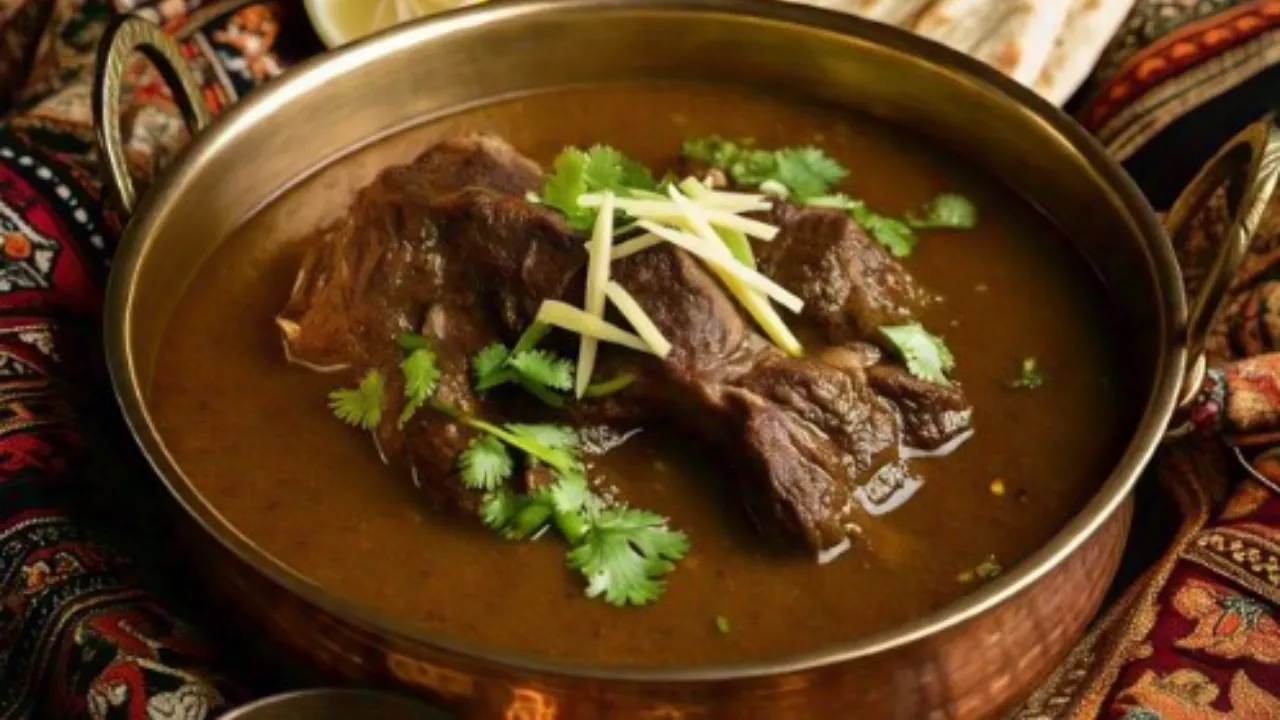Cooking Authentic Pakistani Nihari at Home
Have you ever sampled true Pakistani nihari for these rich, oddly complex flavors? It’s a good hearty stew of tender beef or lamb, cooked for hours with aromatic spices that are very popular all over South Asia.
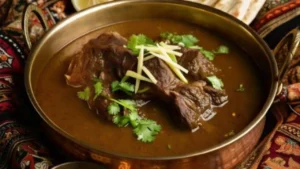
You can recreate this almost gourmet special dish in your kitchen, though it’s traditionally saved for special occasions, but not. Making nihari at home may not appear as easy as we’d all like, but with the right ingredients and techniques, this is an option anyone can benefit from any day of the week.
In this guide, we will teach you the step-by-step process of preparing this iconic Pakistani comfort food to impress family and friends with your culinary prowess. I have 20 years of experience in cooking. So you can trust me.
Introduction to Nihari: A Pakistani Culinary Treasure
Pakistani cuisine is incomplete without nihari, a rich stew, slow-cooked like baby rhinos all over. This hearty dish, essentially a royal delicacy of the Mughal era, has become a much-loved street food staple in the Indian subcontinent.
The Essence of Nihari
Nihari is practically all meat, generally in the form of beef shank or lamb, but tender enough to fall apart, slowly simmered in an extravagant mix of spices at its core. It ends up being velvety, aromatic gravy that sticks to the falling-off-the-bone meat.
Because it is prepared overnight and served at dawn, it was a Muhajir dish and sometimes referred to as Nahiari, which was named after the Arabic word Nahar meaning morning.
A Symphony of Flavors
The main factor that separates one from nihari is the masala or spice blend used in the separate dish. This very carefully cobbled-together mix will often contain:
-
Ginger and garlic
-
Coriander and cumin
-
Fennel and star anise
-
Cardamom and cinnamon
The collagen-rich meat and these spices work in concert to throw up a deep, inherently satisfying, warming, invigorating dish.
Cultural Significance
Having Nihari is not only about having food in Pakistan, but it is more than that; it’s an identity. Actually, it is traditionally consumed during weddings, the feast of purification, family reunions, or simply any ordinary day.
That’s what comes to mind whenever people speak of Pakistani culture: sharing Nihari with ginger, coriander, and lemon juice all spread over it, or rice topped with those elements and served to the community.
The Secret to Authentic Nihari Flavors
This richness and complexity of flavor are what makes authentic Nihari the key to the building. This well-known Pakistani dish is known for the amount of spices and time and the proper balance of them that goes into it to create its depth and intensity.
The Spice Blend
The masala at the heart of Nihari’s spicy taste comprises a wide range of spices. This blend typically includes:
-
Coriander seeds
-
Cumin seeds
-
Fennel seeds
-
Black peppercorns
-
Cinnamon
-
Cardamom
-
Cloves
Most often the spices are dry roasted to really bring out the flavor before being ground into a powder. This is a fragrance and a warming mix that becomes the basis for this dish.
Slow-Cooking Magic
The reason Nihari is melt-in-your-mouth and has a deep flavor is due to its long, slow cooking. The dish is traditionally simmered overnight (ideally for at least 6-8 hours), so the meat melts into deliciousness in its sorriness.
Not only does this slow cooking method draw collagen from the bones to create a rich, gelatinous texture akin to authentic Nihari in taste, but it also makes for a dish that is not too dry and greasy, as similar preparations can sometimes be.
The length of time that’s depended on for the spices to ‘melt’ into the meat and stock enhances the flavor and makes for one intensely flavored meal.
With the key elements of spice blend and slow cooking mastered, you will be on your way to creating Nihari on par with what you’d find in your local restaurant.
Ingredients: Building Blocks of Authentic Nihari
The Meat Foundation
What sets nihari apart is the meat. Typically, the beef shank is the cut favored for its rich flavor and succulent texture once slow-cooked. If the bone marrow is available, some recipes require it for an even more luxurious, depthily silky final dish.
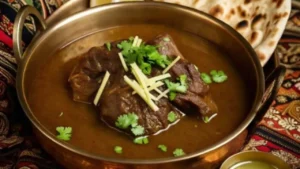
The Aromatic Spice Blend
The nihari masala is essentially the soul of nihari. A blend typically includes whole spices such as cinnamon sticks, cardamom pods, bay leaves ground spices like cumin and coriander, plus the most famous garam masala. The trick is to get the aromatics just right so they balance cleanly and boldly.
The Thickening Agent
Almost always, as a thickening agent to get that signature velvety consistency, the nihari would use wheat or rice flour. Without this ingredient, the broth would remain thin broth; there would be no luscious coating of gravy that clings to the meat and adds a tantalizing taste that comes with every bite.
Finishing Touches
Garnishes just can’t be left out in any nihari. A zesty counterpoint to the rich stew is provided by a squeeze of lemon juice, and the freshness of (fresh) ginger, cilantro, and green chilies, all with a touch of heat. Not only do these final flourishes make a nihari so much tastier, but they lend it visual appeal too.
Essential Tools and Utensils for Cooking Nihari
For homemade Pakistani nihari, it is important to have the right equipment. To make this traditional stuffing dish, you need special tools to get the signature rich texture and deep flavors. Here’s what you’ll need in your kitchen arsenal:
The Cooking Vessel
It is all about a cooking pot, and nihari preparation is its heart. The slow cooking of the meat to tender perfection requires a heavy-bottomed pot or Dutch oven. Pour into a large stainless steel, or even copper, vessel with a deep body and a small or thin body to allow even heating and avoid burning.
Spice Grinder and Mortar-Pestle
These aloo nihari nalla, the complex flavors of nihari are all about freshness. To crush whole spices such as cinnamon, cardamom, and cloves, invest in a really good quality spice grinder. To crush smaller quantities (or create pastes from fresh ingredients like ginger or garlic), you’ll also find a mortar and pestle handy.
Slotted Spoon and Strainer
During a long simmering process, impurities and excess fat will need sweating off. This task requires a very large slotted spoon or a mesh strainer so that the sauce comes out clean and velvety.
Serving Bowls and Garnish Tools
Deep, wide bowls are the best way of presenting the nihari, its rich color and texture. To garnish your masterpiece, make sure you keep a fresh ginger julienne, a small dice of cilantro, and lemon wedges nearby for garnish, ready for use.
Preparing for Perfection: Pre-Cooking Tips
Gathering the Essential Ingredients
Before you set out on the nihari-making path, make sure you have all the necessary ingredients prepared. Meat: high quality and fresh, especially the star of the show traditionally beef shank or lamb.
Never be far away from the aromatic spices that make nihari what it is: ginger, garlic, and most importantly the nihari masala. To get it right, use wheat flour for the thickening agent, ‘atta.’
Marinating for Maximum Flavor
The most suitable addition to enhance the taste of nihari is the marination of the meat overnight. While the order doesn’t strictly require it, it’s amazing how doing one of these can make the dish taste much better.
For a simple marinade, mix yogurt, a pinch of your nihari masala, and paste made of ginger-garlic. It not only perfuses the meat with flavor but also softens the meat, thereby rendering a refuse in your mouth texture of nihari that’s well prepared.
Setting Up Your Kitchen
The preparation of nihari is a labor of love, and everything about it takes a certain time. For efficient packing of your kitchen space, do so before you begin your cooking processes. The sequence is relevant for the addition of spices, so it is important to have all the spices on hand.
There are two things to keep in mind when cooking nihari: first of all, equipped with a big, heavy base vessel, such as a pot or pressure cooker, it is beneficial to cook for a long time at a low temperature.
With all this in place, then the nihari you prepare will be as authentic as the best restaurant might be making.
Step-by-Step Recipe: Cooking Authentic Nihari at Home
Preparing the Ingredients
First comes getting all the necessary ingredients. For thickening, you will need wheat flour and beef shanks, bone marrow, and a blend of aromatic spices: ginger, garlic, and fennel seeds. Authentic Nihari takes time to cook, and you want to make sure you have plenty of time.
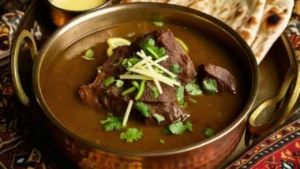
Marinating and Cooking the Meat
Marinate the beef shanks with a yogurt and spices mixture for at least 2 hours. Basically, this tenderizes the meat and adds flavor. Secondly, heat olive oil in a large pot and sauté onions until golden brown.
Brown also the marinated meat and bone marrow on each side. When the meat is still difficult to chew, pour in water and boil, then take it off the heat and allow it to continue simmering for four to six hours.
Creating the Signature Nihari Gravy
Dry roast and grind whole spices for preparing Nihari masala while the meat cooks. In a separate pan, also make a roux from wheat flour and ghee. Mix this, gradually adding it to the simmering meat, stirring constantly.
Then, finally, add in the ground Nihari masala and put it to cook for another 30 minutes till the gravy becomes as thick as a velvety consistency. Warm it up, and garit nish with fresh ginger, cilantro, and a squeeze of lemon for the Pakistani dining experience.
Garnishing and Serving: Elevating the Nihari Experience
With the finishing touches, your created Nihari will become an incredible-looking dish and not just a good one. It not only improves the visual appeal of the dish by using the right garnish techniques but also layers flavor and texture into one of the richer, more hearty stews.
Traditional Garnishes
Start fresh by finely chopping some fresh ginger and some green chilies. Take some advice and spear these over the boiling Nihari to add a spicy kick and proper aroma. Then, sprinkle fresh marbled cilantro leaves to give a pop of color and crispness. To give diners that authentically lemony touch, add a wedge of lemon on the side to control the tanginess of taste.
Complementary Sides
Serving your Nihari with freshly baked naan bread or crisp kulcha will be a delight for you. Accompanied with this flavorful gravy, they make wonderful flatbreads to soak up the gravy. If it’s for added indulgence, give a small bowl of ghee on the side. This clarified butter in a dollop melts into the hot Nihari to add that extra luxury.
Presentation Tips
Deep, wide bowls are used to ladle the Nihari into. Stack these garnishes in interesting ways on top, contrasting them in a visually pleasing way. For a traditional touch, serve in a copper or brass dish, which both looks wonderful and keeps the dish warm.
Adjusting the Recipe for Dietary Preferences
Vegetarian and Vegan Options
Now, though it’s still meat-based, you can cook some delicious plant-based versions of the Nihari. Stand up and replace ready beef with thick vegetables like jackfruits, mushrooms, or a combination of lentils and chickpeas.
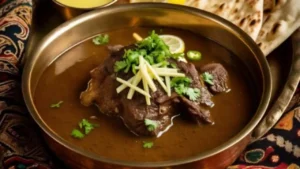
These alternatives offer a nice texture and help absorb the richness of the rich Nihari spices. To make this a vegan option, replace ghee with vegetable oil and coconut cream in place of yogurt for garnish.
Gluten-Free Adaptations
Making Nihari gluten-free is easy for those with gluten sensitivities. All you need to replace the wheat flour used to thicken it with is rice flour or cornstarch. They will all keep the dish consistent but not skimp on flavor.
Make sure that the spices you’re using to blend are gluten-free; some commercial ones contain gluten to serve as an anti-caking agent.
Low-Fat Modifications
If you want your brain lighter version of Nihari, choose lean parts of meat and trim the visible fat before cooking. Simmer with a lid ajar so the oil is used less and excess fat rises to the top. Instead of full-fat, use low-fat or Greek yogurt for a better garnish.
These small changes can easily reduce the calorie amount while keeping the flavors just the same.
Health Benefits of Homemade Nihari
Nutrient-Rich Powerhouse
Nihari is not just yummy food that most people really love to eat, but furthermore, there is a high healthy nutrient content in the gifts of homemade foods! This meal is centered on the foundation of slow-boiled bone broth, providing the human body with collagen, amino acids, and minerals.
Some of them include nutrients that aid digestion, help maintain healthy joints, and enhance the body’s immune system. Furthermore, bones are thought to contain a concentrated level of vitamins and healthy fats.
Protein-Packed Meal
Alternatively, you get tender beef or lamb meat in Nihari that brings the quality up to a luxurious level. If your body is lacking this macronutrient, it can hardly integrate enough muscle that it requires for repair, growth, and functional purposes.
Now, this serving is a lot, and this may well be all you need to increase protein per serving, which helps if you are aiming at balancing your protein every day.
Spice-Induced Benefits
A ‘normal’ Nihari has loads of whole spices, such as ginger, turmeric, and cinnamon, which contribute to the taste but perform some functions too. Rich in anti-inflammatory and antioxidant effects, these ingredients.
Ginger has an ameliorating effect on digestion and could alleviate nausea, and turmeric may decrease the probability of atherosclerosis. Studies show that creating may help control blood sugar levels and reduce the chances of developing type 2 diabetes.
When prepared at home, you’ll get to decide how much spice you want to add and fully harness such a health boost as you desire.
Troubleshooting Common Nihari Challenges
Mastering the Consistency
The reliability of nihari is even more challenging when it comes to reinforcing it. If you find the gravy too watery, to thicken, all you’ll need to do is return it to the skillet and cook for a few more minutes over heat without a lid being placed on the skillet.
Likewise, if it is too thick, just add a little warm water at a time and stir until it becomes as thick as desired. A tip that helps: it is opulent, rich, and smooth, but the ideal nihari should leave a little film on the back of the spoon but should not be sticky.
Balancing the Flavors
The flavor profile of Nihari is complicated. And if your dish is too spicy, throw in a couple of dollops of yogurt or a little splash of cream to relieve the heat. If you’re looking for depth, a little garam masala and a little lemon juice will perk things up. You’ll want to always adjust seasonings gradually, tasting as you go.
Tenderizing the Meat
One problem everyone encounters when preparing nihari is the tough meat. To ensure fork-tender results, consider these tips:
-
Use a pressure cooker to significantly reduce cooking time
-
Marinate the meat overnight in yogurt and spices
-
Simmer on low heat for an extended period, allowing the collagen to break down fully
Patience is key. Remember when you want that melt-in-your-mouth texture that beats the nihari out of its way?
Sharing the Experience: Nihari Across the Globe
The Global Nihari Movement
One of the regional delicacies, Nihari had now become a global sensation. This rich flavor, however, is something Pakistani communities all around the world are bringing with them as they spread.
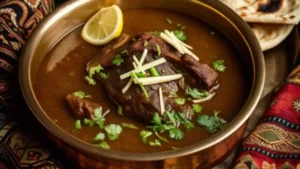
Though nihari is a Karachi dish made from a beef or lamb meat shank, it has spread itself out to bustling London streets and across the diverse neighborhoods of New York.
Fusion and Innovation
Nihari, especially if it’s traditional, is a favorite, but innovative chefs are experimenting with fusion versions. If you live in Los Angeles, you’ll probably be able to find tacos linked to nihari, and if you’re in Tokyo, you might be able to get nihari-flavored ramen.
Each of these creative adaptations demonstrates how nihari’s flavors can be changed and reused, yet they are also bringing newcomers to the dish.
Social Media’s Role
As of today, nihari has become a hit on social media, owing to the fact that it is very popular. Steaming bowls of nihari are mouthwatering; food bloggers and influencers share photos and videos of them, and millions of views online leave food lovers wondering.
Not only has this awareness been pushed further, but people have also been encouraged to take a shot at cooking nihari at home.
Nihari in Pop Culture
Nihari has made it into pop culture as well. That’s why it’s been featured in food documentaries, mentioned in novels, and appeared in Hollywood movies. Of course, this cultural representation has only made nihari even more, if possible, a beloved dish that transcends borders and the universal language of food to bring people together.
Final Thoughts: Mastering Nihari as a Global Foodie
Embracing Culinary Diversity
You know, each time you cook up that Pakistan Nihari, you‘re not just cooking a dish; you’re taking part in the height of a culinary heritage. It’s a centuries-old, slow-cooked, aromatic stew, reining in tradition and a well-seasoned flavor. When you make Nihari at home, you are contributing to the global sharing of culinary knowledge and respect!
The Rewards of Patience and Precision
Nihari is hard to master, and it needs patience and an eye for detail. Though the whole cooking process might take a while and the spices may be blended just right, it’s all well worth the trouble.
The more you begin to master the recipe, the more you will start to have an intuitive understanding of the balance of flavors/ textures that make Nihari so unique.
Sharing the Experience
Sharing Nihari with others as one of the joys of mastering a dish, however, is a far cry from making a soup for a day spent at home. Before showing off your cooking skills to your whole extended family or your dinner party guests, consider a dinner party and simply prepare a batch to share with friends and family.
You not only connect their taste buds but also introduce them to a very lovable Pakistani delicacy; through such exercise, one can foster cultural appreciation through food.
Conclusion
When you’re going to cook your Pakistani nihari at home, remember that patience and focus are essential. This is more than just another meal; it’s a celebration of where we came from and a celebration of tradition!
This guide will show you how to follow the steps outlined, so you can recreate those tantalizing aromas and complex flavors that put nihari on the top of the Pakistani cuisine list. Whether you are cooking for family, and friends, or just treating yourself, your homemade nihari is sure to impress.
Then gather your ingredients, set aside the time, and you’re ready to taste what you have created. Have a great time eating your fabulous, authentic Pakistani nihari!
Frequently Asked Questions
What cut of meat is best for Nihari?
The best cut for authentic Pakistani Nihari is beef or lamb shank. Those cuts have more connective tissue and break well when cooked low and slow into tender and delicious meat. More richly flavored recipes also use oxtail or a mix of cuts.
How long should Nihari simmer?
The Nihari is traditionally simmered for 6 to 8 hours to get the texture and the deep flavor. Nevertheless, the use of a pressure cooker lowers cooking time to some 2 hours, with good results. It’s all about cooking until the meat is fall-off-the-bone tender.
Can I make Nihari in advance?
Nihari gets better in flavor if made a day in advance. Once cooked, allow it to cool completely and place it in the refrigerator overnight. Serve warm over creamy mashed potatoes or cooked pasta and warm either on the stovetop over low heat till you have the desired consistency. It’s letting the flavors get along, really coming into solid and stronger, better flavor.

Hello! My name is Wahab Khan. I, having over 20 years of culinary experience, bring both my knowledge and passion to each Recipe featured here. I create delicious, accessible dishes for beginners and seasoned cooks alike, and think that good food can help connect people. My recipes combine timeless techniques with stellar new spins, allowing readers to master the everyday flavors of the World.
